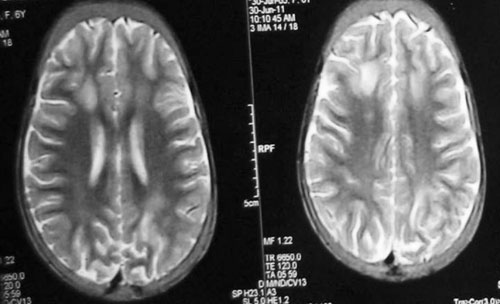|
|
|
Indian Pediatr 2014;51: 504 |
 |
Posterior Reversible Encephalopathy Syndrome
after Transfusion in Hb E-Beta Thalassemia
|
|
Sumantra Sarkar and Rabi Kumar
Department of Pediatrics, IPGMER and SSKM Hospital,
Kolkata, West Bengal, India.
Email: [email protected]
|
|
Posterior reversible encephalopathy syndrome (PRES),
first described by Hinchey, et al. [1] in 1996, is characterized
by headache, confusion, seizures, visual loss and sub-cortical edema on
neuroimaging. Various etiologies like hypertension, infection, eclampsia
and autoimmune disease are implicated. Post-transfusion PRES with
pre-existing hematological disorder like sickle cell anemia has also
been reported [2]. We report PRES after blood transfusion in a child
with Hb E-beta thalassemia.
A 6-year-old girl, known case of Hb E-beta
thalassemia, received two units of packed cells as her pre-transfusion
hemoglobin was 4.8 g/dL. Two days later, she was admitted with several
episodes of projectile vomiting, gradually increasing headache and brief
loss of consciousness. There was no history of head trauma, fever,
seizures, weakness or visual disturbances. Her vitals were stable with
blood pressure of 92/60 mmHg. Glasgow Coma Scale (GCS) score was 12/15;
Cranial nerves, superficial and deep tendon reflexes were normal;
plantars were flexor. Meningeal signs were absent and hepatosplenomegaly
was present.
Complete hemogram and blood biochemistry were normal.
Hepatitis-B surface antigen and antibodies to HCV, HIV 1 and 2 were
negative. CSF examination revealed 5 lymphocytes/mm 3,
sugar of 76 mg/dL and proteins 52 mg/dL. MRI of brain revealed multiple
hyperintensities over subcortical white matter involving cerebral and
cerebellar regions in T2 and Flair images (Fig 1). She
recovered completely by second day with supportive management and was
discharged on the fourth day. Repeat MRI done after six weeks showed
near complete disappearance of hyperintensities.
 |
|
Fig. 1 Brain MRI (T2 and flair)
showing hyperintensities in the cerebral sub-cortical white
matter.
|
Failure of cerebral auto-regulation to counteract the
sudden rise in cerebral blood volume following transfusion is thought to
cause vasogenic edema leading to PRES [3]. Hypoxic damage to endothelial
cells secondary to anemia might also disrupt the integrity of the blood
brain barrier [4]. Rapid rise of hemoglobin has also been implicated
[5].
Reference
1. Hinchey J, Chaves C, Appignani B, Breen J, Pao L,
Wang A, et al. A reversible posterior leukoencephalopathy
syndrome. N Engl J Med. 1996;334:494-500.
2. Kolovou V, Zampakis P, Ginopoulou A, Varvarigou A,
Kaleyias J. Reversible posterior leukoencephalopathy syndrome after
blood transfusion in a pediatric patient with sickle cell disease.
Pediatr Neurol. 2013;49:213-7.
3. Ito Y, Niwa H, Iida T, Nagamatsu M, Yasuda T,
Yanagi T, et al. Post-transfusion reversible posterior
leukoencephalo-pathy syndrome with cerebral vasoconstriction. Neuro-logy.
1997;49:1174-5.
4. Wada K, Kano M , Machida Y, Hattori N, Miwa K H.
Posterior reversible encephalopathy syndrome induced after blood
transfusion for severe anemia. Case Reports Clinical Medicine.
2013;2:332-4.
5. Huang YC, Tsai PL, Yeh JH, Chen WH. Reversible
posterior leukoencephalopathy syndrome caused by blood transfusion: a
case report. Acta Neurol Taiwan. 2008; 17:258-62.
|
|
|
 |
|

